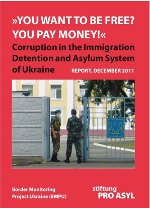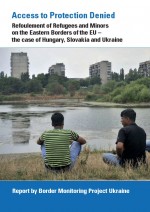The fact that in 2005 the Frontex Headquarters opened in Warsaw, may certainly be considered as a writing on the wall. In the EU “illegal immigration” from and via the east was and still is considered as the main challenge to be met by Migration Control.
The eastern route and the IOM
In the early nineties at the latest the Ukraine caught the eye of the so-called risk analysts, not merely as an emigration country but also as an essential passage for the “eastern human trafficking route”. The country was not an EU-candidate and therefore – contrary to its western neighbouring states Poland, Slovakia, Hungary and Rumania – also not under the obligation to adopt the so-called Schengen Standards. Against this background the IOM (1) at first played the executive part in “outposting” the EU Migration Regime to the most important transit migration country in the east. As early as 1998 an IOM team of experts met with high-ranking Ukrainian government officials in Kiev to start up a “Migration Management Program“. At several levels it was directed against transit migration: the registration and documentation of refugees and immigrants, the set-up of a first deportation camp in Pawschino (2), training courses for the Ukrainian border guards at the US-Mexican border and equipment of a pilot project in Kharkiv (at the Russian border) with radio and infrared technology. “In the course of their work the IOM specialists were confronted with a – for them surprising – problem: they found that more than 70% of the transit migrants entered the Ukraine legally. The government was therefore offered help in introducing new laws and visa regulations. Thus immigration into the Ukraine was first criminalized under the direction of the IOM, in order to be subsequently fought against with means made available by the IOM” (3).
Continue reading ‘Go East! “European Neighbourhood Policy” and Frontex in the Ukraine’
 The Border Monitoring Project Ukraine (BMPU) has produced a report concerning the Refoulement of Refugees and Minors on the Eastern Borders of the EU, the situation in Ukraine and the responsibility of the European Union. The core of the report is based on interviews with refugees and other vulnerable migrants the BMPU conducted in 2009 and 2010.
The Border Monitoring Project Ukraine (BMPU) has produced a report concerning the Refoulement of Refugees and Minors on the Eastern Borders of the EU, the situation in Ukraine and the responsibility of the European Union. The core of the report is based on interviews with refugees and other vulnerable migrants the BMPU conducted in 2009 and 2010.


